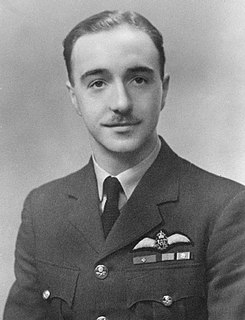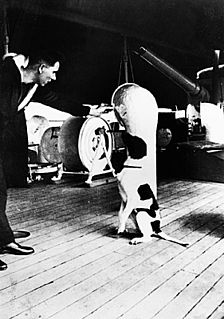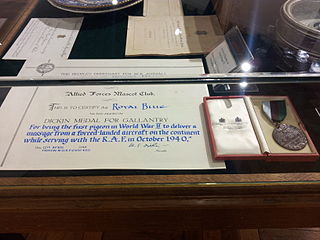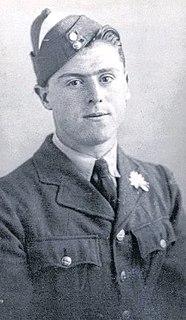Related Research Articles

Homing pigeons have long played an important role in war. Due to their homing ability, speed and altitude, they were often used as military messengers. Carrier pigeons of the Racing Homer breed were used to carry messages in World War I and World War II, and 32 such pigeons were presented with the Dickin Medal.

The PDSA Dickin Medal was instituted in 1943 in the United Kingdom by Maria Dickin to honour the work of animals in World War II. It is a bronze medallion, bearing the words "For Gallantry" and "We Also Serve" within a laurel wreath, carried on a ribbon of striped green, dark brown, and pale blue. It is awarded to animals that have displayed "conspicuous gallantry or devotion to duty while serving or associated with any branch of the Armed Forces or Civil Defence Units". The award is commonly referred to as "the animals' Victoria Cross".

Number 120 Squadron or No. CXX Squadron is a squadron of the Royal Air Force which was established as a Royal Flying Corps unit late in World War I, disbanded a year after the end of the war, then re-established as a RAF Coastal Command squadron during World War II. Although disbanded again a month after Victory in Europe Day, during and after World War II it operated almost continuously, with maritime patrol aircraft; most recently with the Hawker Siddeley Nimrod, based at RAF Kinloss in Scotland until the type's withdrawal in March 2010. The squadron was disbanded again the following year. No. 120 Squadron stood up again in April 2018 at RAF Lossiemouth and became the first squadron to be equipped with the Boeing Poseidon MRA1 anti-submarine warfare (ASW) aircraft on 31 October 2019.

William Reid was a Scottish recipient of the Victoria Cross, the highest and most prestigious award for gallantry in the face of the enemy that can be awarded to British and Commonwealth forces. He earned his Victoria Cross as a pilot in the Royal Air Force Bomber Command during the Second World War.

G.I. Joe was a pigeon noted for his service in the United States Army Pigeon Service. The bird is part of the homing pigeons used during World War I and World War II for communication and reconnaissance purposes. G.I. Joe had the name tag, Pigeon USA43SC6390. He was hatched in March 1943, in Algiers, North Africa and underwent a training for two-way homing pigeons perfected at Fort Monmouth, in New Jersey.

No. 489 (NZ) Squadron was a torpedo bomber squadron established for service during the Second World War. It was a New Zealand squadron formed under Article XV of the Empire Air Training Plan. Although many of its flying personnel were largely drawn from the Royal New Zealand Air Force, the squadron served in Europe under the operational and administrative command of the Royal Air Force as part of Coastal Command.

Judy was a ship's dog on board HMS Gnat and HMS Grasshopper stationed on the Yangtze before and during World War II. She proved able to hear incoming aircraft, providing the crew with an early warning. After part of the crew transferred from the Gnat to the Grasshopper in June 1939 the ship was sent to Singapore after the British declaration of war on Germany. There she was on board the ship during the Battle of Singapore, which saw Grasshopper evacuate for the Dutch East Indies. It was sunk en route, and Judy was nearly killed having been trapped by a falling row of lockers. She was rescued when a crewman returned to the stricken vessel looking for supplies.

The United States Army Pigeon Service was a unit of the United States Army during World War I and World War II. Their assignment was the training and usage of homing pigeons for communication and reconnaissance purposes.
The National Pigeon Service (NPS) was a volunteer civilian organization formed in Britain in 1938 as result of representations made to the Committee of Imperial Defence and the British Government by Major W. H. Osman. During 1939-45 over 200,000 young pigeons were given to the services by the British pigeon breeders of the NPS. The birds were used by the Royal Air Force and the Army and Intelligence Services, Special Section of the Army Pigeon Service. During three and a half years of World War II, 16,554 war pigeons were parachuted onto the continent. One of these was Commando, a red chequer cock bird that became a recipient of the Dickin Medal. Many other NPS pigeons also received the Dickin Medal.
Winkie was a pigeon who won the Dickin Medal in 1943 for assisting in the rescue of an aircrew forced to ditch in the North Sea during the Second World War.

Royal Blue, also known as NURP.40.GVIS.453, was a male pigeon of the RAF pigeon service. He was awarded the Dickin Medal for bravery in March 1945 for being the first pigeon to deliver a message from an allied forced landed aircraft from the European mainland during World War II. He had originally been housed at the Royal Lofts at Sandringham, and was owned by King George VI.
Gustav, also known as NPS.42.31066, was a pigeon of the RAF pigeon service. He was awarded the Dickin Medal, also known as the animals' Victoria Cross, for bringing the first report of the Normandy landings to the British mainland during the Second World War.
Tyke, also known as 'George' and carrying the service number 1263 MEPS 43, was a male Second World War homing pigeon who was awarded the Dickin Medal for gallantry in 1943 for delivering a message from a downed aircrew. His medal was sold for £4,830 ($7,313) in July 2000.
Dutch Coast, also known as NURP.41. A.2164, was a pigeon who received the Dickin Medal in 1945 from the People's Dispensary for Sick Animals for bravery in service during the Second World War.
NPS.42.NS.2780 was a pigeon who received the Dickin Medal in October 1945 from the People's Dispensary for Sick Animals for bravery in service during the Second World War. NPS.42 was cited after delivering important messages three times from enemy occupied territory, in July 1942, August 1942 and April 1943, while serving with the Special Service in Europe.
All Alone (NURP.39.SDS.39) was a war pigeon who was decorated for bravery in service during the Second World War for delivering an important secret message in one day over a distance of 400 miles (640 km), while serving with the National Pigeon Service in August, 1943.
Mercury was a pigeon who received the Dickin Medal in 1946 from the People's Dispensary for Sick Animals for bravery in service during the Second World War.

Royal Air Force Leuchars or RAF Leuchars was a Royal Air Force (RAF) station located in Leuchars, Fife, on the east coast of Scotland. Throughout the Cold War and beyond, the station was home to fighter aircraft which policed northern UK airspace. The station ceased to be an RAF station at 12:00 hrs on 31 March 2015 when it became Leuchars Station and control of the site was transferred to the British Army. The RAF temporarily returned to Leuchars between August and October 2020 to carry out QRA (I) responsibilities while runway works were being carried out at RAF Lossiemouth.

Alexander Ross Sutherland was a Scottish Royal Air Force (RAF) airman. As a teenager he helped establish the Inverness squadron of the Air Training Corps, becoming their first senior non-commissioned officer. Enlisting with the RAF, he became a bombardier/radio operator, flying ten bombing raids over Germany with No. 5 Group RAF in Avro Lancasters during World War II.
References
- 1 2 O'Grady, Richard (21 October 1999). "Don't let bonfire night be a fright". Daily Record. Retrieved 21 April 2012.
- 1 2 "The Dickin Medal - The Animal's VC". The Scots at War Trust. Retrieved 21 April 2012.
- ↑ "Pigeons in War". The Royal Racing Pigeon Association. Retrieved 21 April 2012.
- ↑ "Entertainment for a Pigeon". The Sydney Morning Herald. 9 July 1950. Retrieved 21 April 2012.
- ↑ "Pet SOS: Bravery beyond the coo of duty". Coventry Evening Telegraph. 5 June 2004. Retrieved 21 April 2012.
- ↑ "Royal Seal Of Approval". Sky News. 24 November 2004. Retrieved 21 April 2012.
- 1 2 "Dickin medal pigeons". PDSA. Archived from the original on 13 February 2010. Retrieved 21 April 2012.
- ↑ Houghton-Brown, John (1 January 2012). "Heroic animals finally gain the recognition they deserve". The Independent on Sunday. Archived from the original on 25 January 2013. Retrieved 21 April 2012.